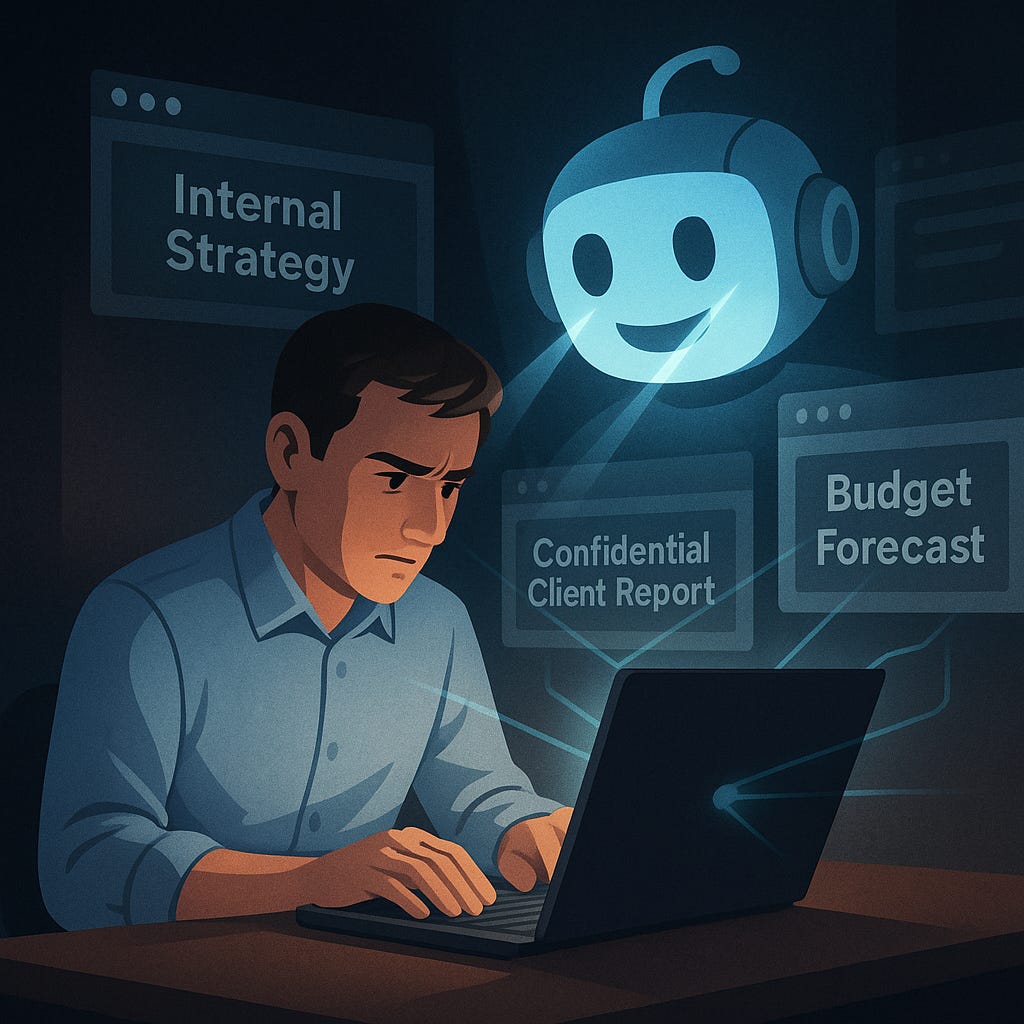Artificial intelligence (AI) has become an everyday tool for employees across countless industries. Whether writing emails, generating code, summarizing reports, or researching competitors, casual use of AI is rapidly normalizing. Yet with every prompt typed and every query answered, organizations are inching toward a major privacy crisis.
Recent research paints a troubling picture: many leading AI tools prioritize commercial gain over data security. Employees may believe they are working smarter, but without realizing it, they are also exposing proprietary information, personal data, and sensitive operations to external actors.
In today's fast-evolving landscape, casual AI use without oversight risks undermining confidentiality, eroding trust, and compromising competitive advantage. Organizations cannot afford to stay complacent.
The Hidden Privacy Risks in AI Tools
A study by Surfshark examined how popular AI chatbots manage user privacy. The findings are alarming. Out of 30 AI platforms analyzed, only a handful demonstrated any commitment to user data protection (Surfshark, 2025). Most either collected unnecessary personal information or left data handling practices ambiguous. Some tools even admitted that user prompts could be shared with third parties for marketing or used to train new AI models without consent.
The implications are profound. A single prompt asking an AI to draft a project proposal could embed confidential client strategies into a third-party dataset. A quick request to summarize internal research could leak valuable intellectual property. What employees see as simple productivity hacks are, in fact, doorways to uncontrolled data exposure.
Employees often treat AI like private notebooks. In reality, they are engaging with external systems that act more like public whiteboards, capturing and disseminating inputs far beyond their original context. Unless businesses intervene, the casual use of AI tools will quietly and steadily magnify their privacy risks.
When the Browser Is Watching
Surfshark’s findings on chatbots are concerning enough, but a newer trend compounds the danger: AI-powered browsers that monitor user behavior in real time.
According to TechCrunch, Perplexity, an emerging AI search and browsing platform, plans to log detailed user actions to build hyper-targeted advertising profiles (Perez, 2025). Every page visited, every link clicked, and every query made could be harvested, analyzed, and sold.
This development raises urgent red flags. Professionals browsing market intelligence, competitor websites, or confidential vendor portals could unknowingly leave a breadcrumb trail of sensitive strategic insights. Once logged and cross-referenced, these behavioral patterns could reveal internal operations or upcoming initiatives to outside parties.
Adding to the risk, modern data markets excel at reidentification. Even when AI browsers claim to anonymize information, scattered fragments can be pieced back together, exposing companies to regulatory violations, reputational harm, or competitive sabotage.
In short, using AI browsers without airtight controls is like working with an invisible observer sitting behind every employee. That observer is always noting every move and filing it away for future exploitation.
The Myth of "Safe Enough" AI Use
Many organizations rationalize casual AI use with the assumption that mainstream platforms are inherently safe. This belief is dangerously outdated.
Surfshark’s analysis showed that even among household-name AI brands, user privacy protections vary widely (Surfshark, 2025). Some popular tools retain inputs indefinitely or quietly share them with third parties. Marketing promises of "private" or "secure" AI experiences often hide the reality that data is still being used to refine algorithms or build new services.
Also, the risk does not end with obviously sensitive data. Seemingly harmless prompts, such as casual mentions of new projects, potential hires, customer names, or rough financial estimates, can accumulate into detailed corporate profiles when gathered across sessions and accounts.
Organizations must understand that AI risk is not isolated to single prompts or obvious disclosures. It is cumulative. Every interaction builds another layer of visibility into a company’s inner workings, often without the company’s knowledge.
How Casual AI Use Threatens Trust
Beyond regulatory or competitive threats, the greatest long-term casualty of uncontrolled AI use may be organizational trust.
Employees trust their workplaces to protect the work they do. Clients trust their vendors to protect the sensitive information they share. When AI mishandling leads to breaches, even inadvertent ones, that trust is shattered.
A single leak revealing a client's confidential project, an internal budget draft, or an upcoming merger plan could unravel years of relationship-building. Worse, once trust is broken, rebuilding it can be slow, costly, and uncertain.
The perception of negligence carries serious weight. In today's climate, failing to safeguard privacy and confidentiality looks less like an unfortunate mistake and more like a systemic leadership failure. Organizations that allow casual AI use without accountability are signaling that data protection is optional, not essential.
Building a Stronger AI Privacy Framework
Addressing the risks posed by casual AI use requires more than issuing guidelines or relying on employee good judgment. Organizations must build a comprehensive framework that treats AI privacy as a critical enterprise risk.
Key elements of such a framework include:
Clear AI Usage Policies: Employees need explicit instructions on which AI tools are permitted, what types of tasks they can support, and what information must never be entered into external systems.
Approved Tool Lists: Only vetted, privacy-compliant AI platforms should be authorized. Unapproved AI tools should be proactively blocked through technical controls.
Ongoing Employee Training: Training cannot be a one-time event. It must be part of ongoing professional development, with case studies, real-world examples, and regular updates as threats evolve.
Data Monitoring and Anomaly Detection: Organizations should monitor for suspicious usage patterns, such as uploads of large volumes of text to AI systems or repeated queries involving sensitive topics.
Vendor Risk Management: AI vendors must be subjected to the same privacy and security vetting processes applied to any critical third-party software provider.
Incident Response Planning: Companies should build AI-specific protocols into their data breach response plans. When leaks happen, speed and transparency are crucial.
Leaders must embed AI privacy considerations into broader enterprise risk management strategies, treating AI exposure as seriously as cybersecurity, financial fraud, or compliance violations.
The Stakes Are Rising
AI capabilities are advancing rapidly. Tools are now better at writing, coding, analyzing, and summarizing than ever before. At the same time, data collection techniques are becoming more sophisticated, and the marketplace for behavioral and proprietary data is booming.
The temptation for employees to casually offload work to AI tools will continue to grow. Without deliberate action, companies will find themselves bleeding critical information out through a thousand tiny cuts.
Organizations that move now to formalize AI usage, strengthen controls, and build a culture of responsible AI adoption will not only avoid painful breaches — they will position themselves as trusted stewards of data privacy in a marketplace where trust is a vanishing commodity.
The AI era demands vigilance, not complacency. In the end, casual mistakes today could cost everything tomorrow.
References
Perez, S. (2025, April 24). Perplexity CEO says its browser will track everything users do online to sell hyper-personalized ads. TechCrunch. https://techcrunch.com/2025/04/24/perplexity-ceo-says-its-browser-will-track-everything-users-do-online-to-sell-hyper-personalized-ads/
Surfshark. (2025). AI chatbots and user privacy: A comparative analysis. Surfshark Research. https://surfshark.com/research/chart/ai-chatbots-privacy









